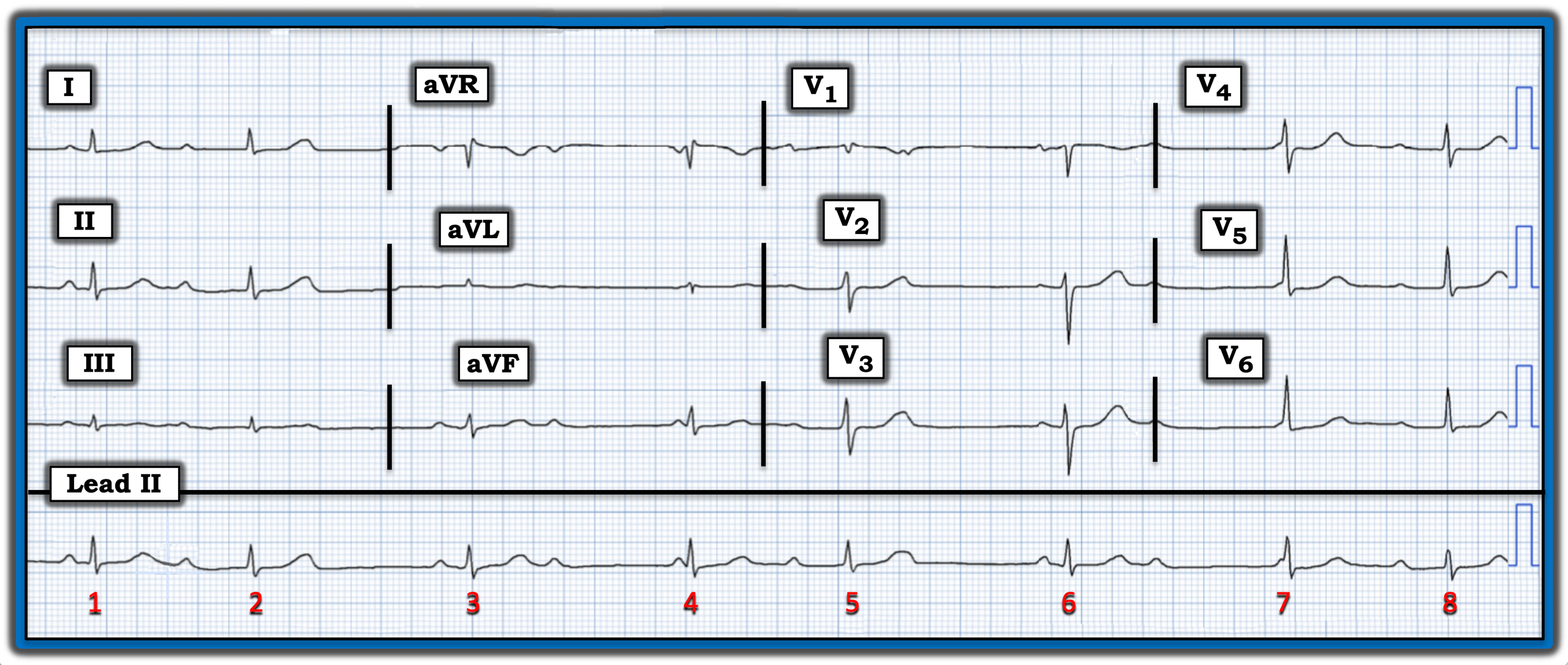How Does the 12-Lead Help?
November 15, 2024
By Ken Grauer, MD
You are given the electrocardiogram (ECG) in the figure without the benefit of any history.
- How would you interpret this tracing?
- How does the 12-lead ECG help with interpretation of the rhythm?

Interpretation: I began my interpretation of today’s tracing by looking at the long lead II rhythm strip.
- The QRS is narrow — so the rhythm is supraventricular.
- The rhythm is not regular. Instead, there are two basic groups of beats — with either longer or shorter R-R intervals (i.e, the R-R intervals between beats 1-2, 4-5, and 7-8 are all similar, and the longer R-R intervals between beats 2-3, 3-4, 5-6, and 6-7 are all of similar duration).
- P waves are present. Although difficult to be certain without calipers, I suspect the reason the T waves of beats 2 and 5 are “fatter” is that on-time P waves are hidden within these T waves. If so, then the atrial rhythm is most probably regular enough to qualify as sinus arrhythmia.
- Whenever you see “group beating” in association with an underlying regular (or almost regular) sinus rhythm, consider the possibility of AV Wenckebach (second-degree AV block, Mobitz Type I).
- The PR interval before narrow beats 4 and 7 clearly is too short to consider conduction. Since the QRS complex of these beats is narrow, beats 4 and 7 must be junctional escape beats. And since the R-R interval preceding beats 4 and 7 is similar to the R-R interval before beats 3 and 6, it is likely that beats 3 and 6 are also junctional escape beats.
- In contrast, beats 2, 5 and 8 all occur earlier than expected. This suggests that, even though the PR interval before these beats varies, it is likely that beats 2, 5, and 8 are all probably conducted, albeit with first-degree AV block.
How does the 12-lead ECG help with interpretation of the rhythm?
- Note how flat the ST-segments are in leads V2 and V3. Normally, there should be a slight, upward-sloping ST-elevation in these two leads. If this patient had recent chest pain, acute posterior infarction would need to be considered, since this is a common cause of ST depression (or inappropriate ST flattening) that is maximal in leads V2, V3, and/or V4.
Impression: This is a very challenging ECG — especially since we are not provided with any clinical history. That being said, the finding of “group beating” in a supraventricular rhythm in which there is an underlying sinus rhythm with conducted beats manifesting first-degree AV block immediately should suggest the possibility of second-degree AV block, Mobitz Type I.
- The most common setting for AV Wenckebach is acute or recent inferior and/or posterior infarction. Therefore, the moment I saw the inappropriate ST-segment flattening that was most marked in leads V2 and V3, I immediately suspected AV Wenckebach as a result of recent posterior infarction.
- The reason today’s rhythm is so challenging is that we see multiple junctional escape beats that mask what otherwise would be the typical picture of Mobitz I (i.e., with progressive PR interval prolongation until a beat is dropped).
Note: For more information about this case, visit https://tinyurl.com/KG-Blog-421.
You are given the electrocardiogram (ECG) in the figure without the benefit of any history. How would you interpret this tracing? How does the 12-lead ECG help with interpretation of the rhythm?
You have reached your article limit for the month. Subscribe now to access this article plus other member-only content.
- Award-winning Medical Content
- Latest Advances & Development in Medicine
- Unbiased Content